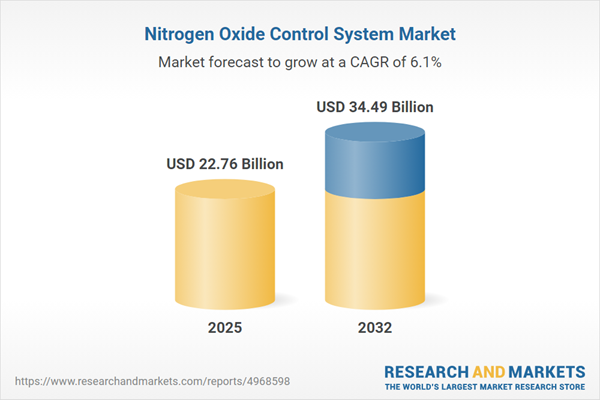Speak directly to the analyst to clarify any post sales queries you may have.
Senior decision-makers navigating the nitrogen oxide control system market must balance strict compliance requirements, operational efficiency, and evolving technology standards. As regulations and stakeholder expectations intensify, organizations are under pressure to adapt strategically and maintain competitive advantages through timely policy response and sustainable technology investments.
Nitrogen Oxide Control System Market Snapshot
The nitrogen oxide control system market is experiencing strong growth driven by tightening global emissions policies and expanding demand for innovative emissions management solutions. With a current market value of USD 21.46 billion, projections forecast an increase to USD 22.76 billion by next year and a longer-term potential to reach USD 34.49 billion by 2032, underpinned by a compound annual growth rate (CAGR) of 6.10%. Continuing policy evolution and heightened need for next-generation NOx mitigation technology fuel this momentum. Industries such as power generation, manufacturing, and the broader energy sector are at the forefront, modernizing emissions strategies and ensuring their compliance approaches remain robust and reliable despite shifting regulatory frameworks.
Nitrogen Oxide Control System Market: Scope & Segmentation
A structured understanding of the nitrogen oxide control system market’s segmentation equips organizations to strengthen procurement processes, anticipate regulatory changes, and direct strategic investments optimally. Each segment plays a distinctive role in supporting tailored operational and compliance strategies that align with industry-specific requirements.
- Technology: Options include Selective Catalytic Reduction (SCR), which provides flexible integration and high efficiency across various processes, and Selective Non-Catalytic Reduction (SNCR) for cases prioritizing simpler installation or lower capital expenditure.
- Installation Type: Greenfield projects provide organizations the opportunity to build compliance into operations from inception, while retrofit approaches enable upgrading of active facilities with minimal workflow interruption.
- End Use Industry: Sectors such as chemicals, power, food and beverage, marine, and oil and gas represent major demand centers, each facing distinct regulatory pressures that shape adoption timelines and technology evaluations.
- Sales Channel: Direct engagements with original equipment manufacturers, aftermarket service contracts, and collaborative strategic partnerships optimize system uptime and lifecycle efficiency.
- Region: The Americas, Europe, Middle East & Africa, and Asia-Pacific feature prominently, as regulatory regimes and supply chain variables differ across geographies, necessitating localized procurement and compliance measures.
- Company Coverage: Leading technology vendors include Johnson Matthey plc, BASF SE, Haldor Topsoe A/S, Honeywell International Inc., Ecolab Inc., DuPont de Nemours, Mitsubishi Heavy Industries, Hitachi Zosen Corporation, Alfa Laval AB, and Emerson Electric Co., each setting benchmarks and driving technology advancements in this field.
Attentive monitoring of these dimensions is vital for selecting suppliers, assessing emerging technologies, and strengthening risk controls within regulated operating environments.
Key Takeaways for Senior Decision-Makers
- Investing in advanced NOx mitigation technologies allows organizations to stay ahead of regulatory requirements while reinforcing proactive compliance positions.
- Integrating real-time analytics into emissions systems elevates process transparency, enhances operational risk detection, and supports continuous emissions performance improvements.
- Establishing durable supplier and OEM relationships provides stability within dynamic market landscapes and supports consistent system reliability despite supply chain uncertainties.
- Partnering with specialized providers helps to navigate complex regulatory transitions, enabling uninterrupted operations and minimizing compliance vulnerability.
- Tailoring compliance strategies for each region addresses varied regulatory demands, strengthening an organization’s position in both established and emerging markets.
- Adoption of leading NOx reduction technologies contributes to broader organizational sustainability goals and enhances operational resilience in highly regulated sectors.
These approaches position leadership teams to build organizational agility and manage evolving compliance and operational risks effectively.
Tariff Impact on Cost and Supply Chain Structure
Anticipated U.S. tariffs set for implementation in 2025 are motivating business leaders to reevaluate sourcing and partnership strategies in the nitrogen oxide control system sector. Increasing engagement with domestic suppliers and expanding local partnerships help counteract cost variability and ensure supply security. Diversifying catalyst sources and refining procurement frameworks protects ongoing projects from delays and cost fluctuations, maintaining operational continuity in the face of changing global trade dynamics.
Methodology & Data Sources
This market analysis utilizes insights from industry expert interviews, technical evaluations, and comprehensive regulatory reviews, complemented by robust data modeling. Scenario-based methodologies ensure that findings remain relevant and actionable for leaders across diverse industry contexts.
Why This Nitrogen Oxide Control System Report Matters
- Provides strategic guidance to anticipate regulatory changes and align investments with evolving emissions management requirements.
- Enables coordinated decision-making across compliance, procurement, and operational domains, supporting organizational resilience and effective risk management.
- Offers informed strategies for managing exposure to global supply chain pressures and tariff challenges, preserving long-term operational stability.
Conclusion
Focusing on technological innovation, process automation, and robust supplier networks equips organizations to strengthen compliance readiness and operational resilience as industry standards continue to advance.
Additional Product Information:
- Purchase of this report includes 1 year online access with quarterly updates.
- This report can be updated on request. Please contact our Customer Experience team using the Ask a Question widget on our website.
Table of Contents
3. Executive Summary
4. Market Overview
7. Cumulative Impact of Artificial Intelligence 2025
Companies Mentioned
The companies profiled in this Nitrogen Oxide Control System market report include:- Johnson Matthey plc
- BASF SE
- Haldor Topsoe A/S
- Honeywell International Inc.
- Ecolab Inc.
- DuPont de Nemours, Inc.
- Mitsubishi Heavy Industries, Ltd.
- Hitachi Zosen Corporation
- Alfa Laval AB
- Emerson Electric Co.
Table Information
| Report Attribute | Details |
|---|---|
| No. of Pages | 184 |
| Published | October 2025 |
| Forecast Period | 2025 - 2032 |
| Estimated Market Value ( USD | $ 22.76 Billion |
| Forecasted Market Value ( USD | $ 34.49 Billion |
| Compound Annual Growth Rate | 6.1% |
| Regions Covered | Global |
| No. of Companies Mentioned | 11 |









